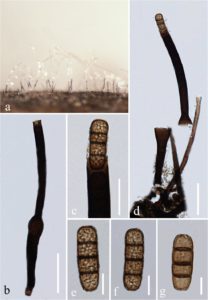Sporoschisma phaeocentron W.H. Ho, K.D. Hyde& Goh, Mycol. Res. 101(11): 1299 (1997)
Index Fungorum number: IF 443110; Facesoffungi number: FoF 02378
Saprobic on submerged decaying wood. Sexual morph: Undetermined. Asexual morph: Colonies effuse, black, hairy. Capitate setae present, erect, straight or flexuous, smooth, pale brown, paler towards the subhyaline apex, septate, 111 − 147 × 4–5 μm (x = 129×4.5 μm, n = 10), apex swollen, with mucilage. Conidiophores macronematous, mononematous, smooth, dark brown, erect, straight or slightly flexuous, gregarious, with a cylindrical stipe and a swollen venter, thick-walled, 178–196 μm long, 7–9 μm wide below venter and 10–12 μm wide above, 17–19 μm wide at venter. Conidiogenous cells monophialidic, integrated, terminal, lageniform, brown. Conidia catenate, cylindrical, more or less rounded at the apex, 25.5–29.5 × 9–10 μm (x = 27.5 × 9.5 μm, n = 35), aseptate and hyaline when young, becoming (1–2)–3- septate, brown to dark brown, verruculose, with slightly thickened wall and septa at maturity.
Material examined – CHINA, Yunnan Province, saprobic on decaying wood submerged in a stream in Cangshan Mountain, July 2014, Y. Su, 2HLXM H 99-2 (HKAS 84039).
Notes – The fresh materials of Sporoschisma were collected in a stream in Cangshan Mountain, Yunnan, China. The size of conidiophores, setae and conidia agree well with the Sporoschisma phaeocentron (Goh et al. 1997). Sporoschisma phaeocentron was reported from Malaysia (Goh et al. 1997), and this is the first record for China.

